Reverse e-auctions are changing how businesses in the Philippines buy things online, making it easier for everyone involved. Buyers can get better deals, while sellers enjoy a fair and open bidding process. This method not only simplifies the buying process but also helps cut costs, which is especially useful for smaller businesses. Because of these benefits, industries like retail, healthcare, automotive, manufacturing, and construction are using reverse auctions more and more to work more efficiently and stay competitive.
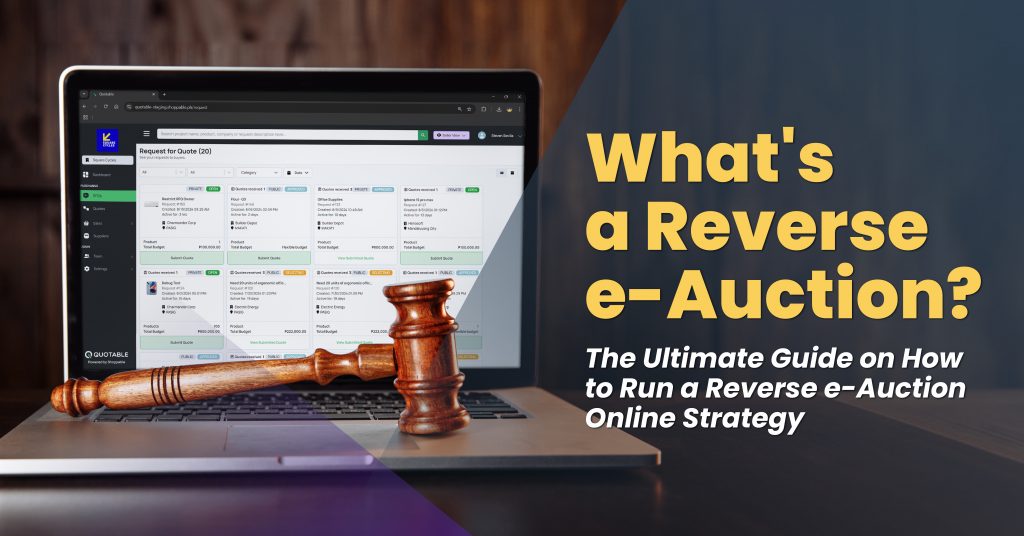
What are Reverse e-Auctions?
In a reverse auction, sellers compete by lowering their prices to win a buyer’s procurement needs. Instead of buyers offering more money, sellers keep reducing their prices until the buyer picks the best deal.
What are Alternative Terms for “Reverse Auction?”
- e-Procurement
- Procurement Auction
- Purchasing Auction
- Sourcing Event
- B2B Auction
How do Reverse e-Auctions Work?
Buyers start reverse auctions by requesting a product or service and asking sellers to bid with their lowest prices. The seller who offers the lowest bid and meets all the requirements wins the contract. With online auction platforms making real-time competition possible, reverse auctions have become increasingly popular. Today, they are widely used by large companies, government agencies, and businesses in the Philippines to purchase everything from raw materials to services like accounting and media production services.
What are the Benefits of Reverse e-Auction to Online Buyers?
In a reverse auction, sellers compete to provide their goods or services, rather than buyers competing to buy. This method offers several advantages for buyers:
- Better Prices: As sellers try to win the buyer’s procurement needs, they often lower their prices, leading to more favorable deals.
- Faster Process: The auction setup makes it easier for buyers to compare offers quickly, cutting down on time spent researching.
- On-Time Deliveries: The fixed deadlines in reverse auctions encourage sellers to meet agreed-upon delivery and production schedules.
What are the Benefits of Reverse e-Auction to Online Sellers?
Reverse e-auctions offer several benefits for sellers, like having access to new markets, easing the bidding process, and improving payment terms:
- Access to More Buyers: Sellers can bid on projects from buyers around the world, not just locally or regionally.
- Fair Competition: All sellers get the same information and proposal requests, which makes the process transparent and fair.
- Opportunities for Small Businesses: Small companies can compete more easily, as reverse auctions don’t favor larger firms with established connections.
- Faster Process: The quick nature of reverse auctions helps sellers move on to other opportunities more efficiently.
- Clear Payment Terms: Buyers clearly outline their needs in the auction, reducing confusion and making payment terms straightforward for sellers.
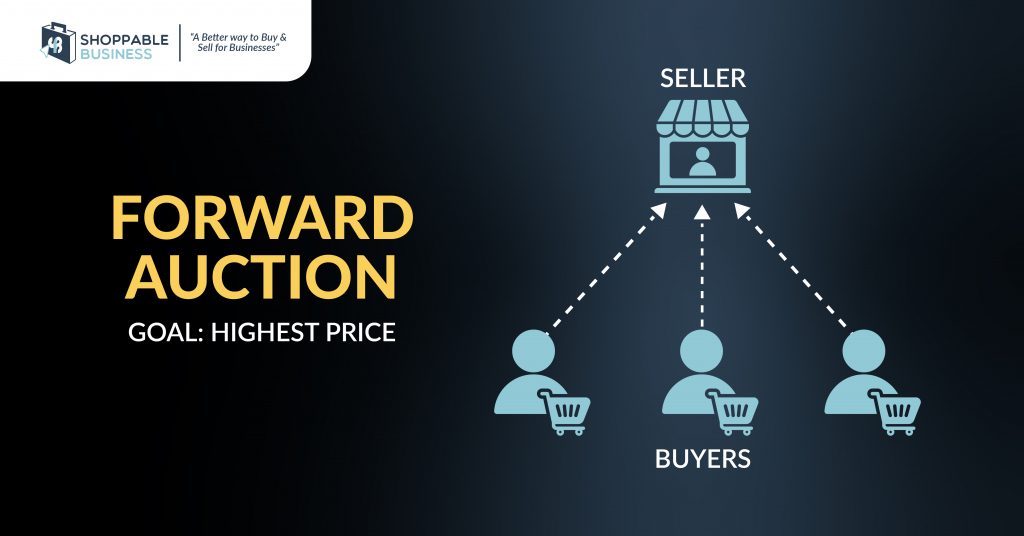
Price-Based Differentiation
What is a Forward Auction?
A Forward Auction, also called a Traditional or Standard Auction, is where buyers compete by offering higher bids, which raises the price of the item. Buyers usually look up information about the product before bidding to understand its worth. The auction goes on as long as buyers keep making higher bids, with the price going up based on how many people are interested.
Forward auctions work well for things like collectibles, artwork, luxury items, cars, jewelry, real estate, second-hand goods, rare items, and special services.
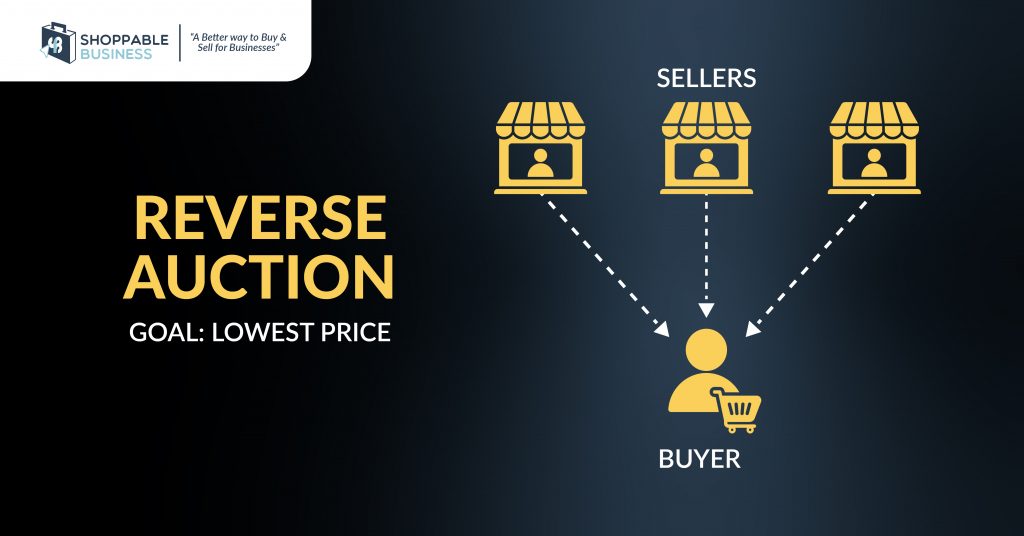
What is a Reverse Auction?
In a reverse auction, sellers try to win business by offering lower prices for their products or services. Instead of buyers raising their bids, sellers lower their prices to make their offers more appealing and stand out. Sellers compete to provide the best value, especially since these auctions often involve large orders.
What are some examples of reverse e-auctions in the Philippines?
Reverse auctions are useful in certain situations in the Philippines and elsewhere. Here are a few examples:
- Manufacturers: Companies that need products often use reverse auctions to find suppliers. For example, a real estate company needing construction materials might run a reverse auction where industrial supply makers compete to offer the lowest price. This helps the company get a good deal and simplifies comparing offers.
- Government Contracts: Agencies like the Bureau of Internal Revenue (BIR) in the Philippines use reverse auctions to buy materials for their TIN ID production, or the Income Tax Return (ITR) documents they release. They use these auctions to get the best prices from suppliers.
Types of Reverse Auctions and How They Work
Ranked Reverse Auction
In a Ranked Reverse Auction, buyers usually use a procurement platform, such as Quotable, where suppliers submit bids that are usually similar in price and details. The winner is chosen based on more than just the lowest bid; factors like quality and delivery time are also considered. This helps buyers pick the best overall option. Even if a supplier’s bid is higher, the clear criteria help ensure the best choice is made.
Open or English Reverse Auction
The English Reverse Auction is often used to buy common items. It starts with a high price set by the buyer, which then goes down over time. Suppliers offer lower bids as the price drops, trying to give the best deal. This method helps buyers get good prices and compare offers while keeping quality in mind.
Japanese Reverse Auction
In a Japanese Reverse Auction, the buyer starts with an initial price. Suppliers can decide to accept or reject this price. If several suppliers accept, the buyer will gradually lower the price during the auction. This continues until only one supplier remains. This type of auction encourages suppliers to compete and helps buyers get the best deal through price reductions.
Dutch Reverse Auction
In a Dutch Reverse Auction, buyers set their needs for price, quantity, and terms from the start. Suppliers who can meet these needs then submit their bids. This auction speeds up the buying process and is useful for things like raw materials, food, IT services, and medical supplies. It helps both buyers and suppliers get good deals quickly.
Tips for a Successful Reverse e-Auction
Invite a Variety of Suppliers
Bring in different suppliers to join the auction. More bidders mean more competition, which can lead to better deals.
Clearly State Your Needs
Explain exactly what you need in terms of cost, quality, and other important details. This helps all suppliers compete on the same basis, making it easier to compare their offers.
Be Transparent
Clearly explain the auction rules, your buying process, and your company’s values. Being open helps build trust with suppliers and sets clear expectations.
Check Supplier Credentials
Make sure each supplier meets your standards and can deliver what they promise. This ensures you’re working with reliable suppliers.
Gather Supplier Information
Collect detailed information about potential suppliers to make informed choices. Knowing their capabilities and past performance helps you select the best option.
Use E-Procurement Tools
Track the auction in real-time with e-procurement software. Quotable is a great choice, offering tools to manage bids, compare quotes, negotiate terms, and improve your procurement process.
Note: Quotable’s e-auction feature is still being developed and will be available soon!
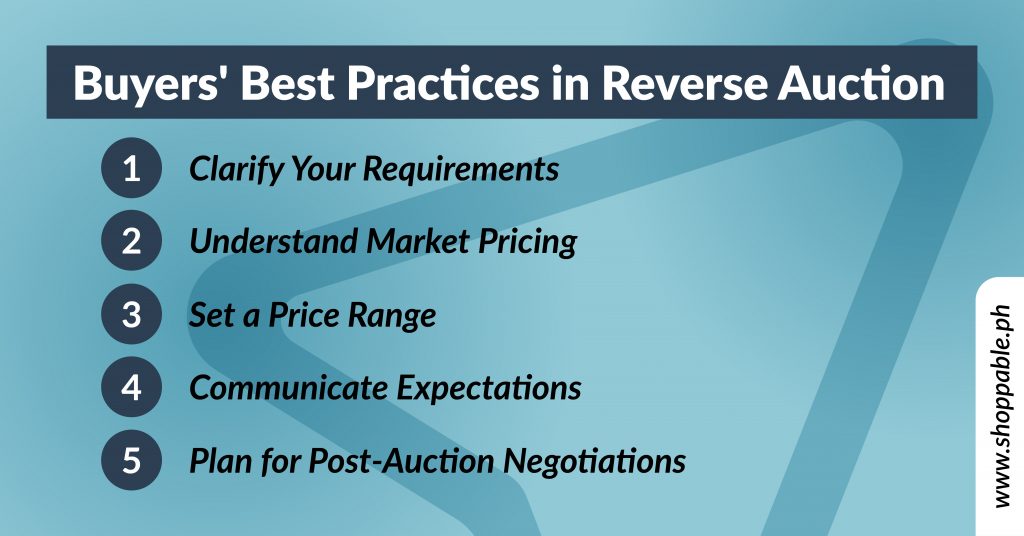
1. Define Your Needs
Make sure your Request for Proposal (RFP) explains exactly what you need. Clear details help suppliers provide accurate bids and reduce confusion.
2. Know Market Prices
Know the current prices for what you’re buying. This helps you identify good deals and avoid paying too much.
3. Set a Starting Price
Start the auction with a price that’s close to or slightly above market value. This attracts suppliers to participate. As the auction progresses, suppliers will compete to offer lower prices, helping you get the best deal.
4. Clarify Your Evaluation Criteria
Clearly outline how you’ll evaluate bids and what you’re looking for. This helps suppliers submit offers that match your needs.
5. Manage Post-Auction Requirements
After the auction, clearly communicate payment terms, delivery schedules, and other details. With the best price secured, ensure all terms are understood to keep the process smooth.
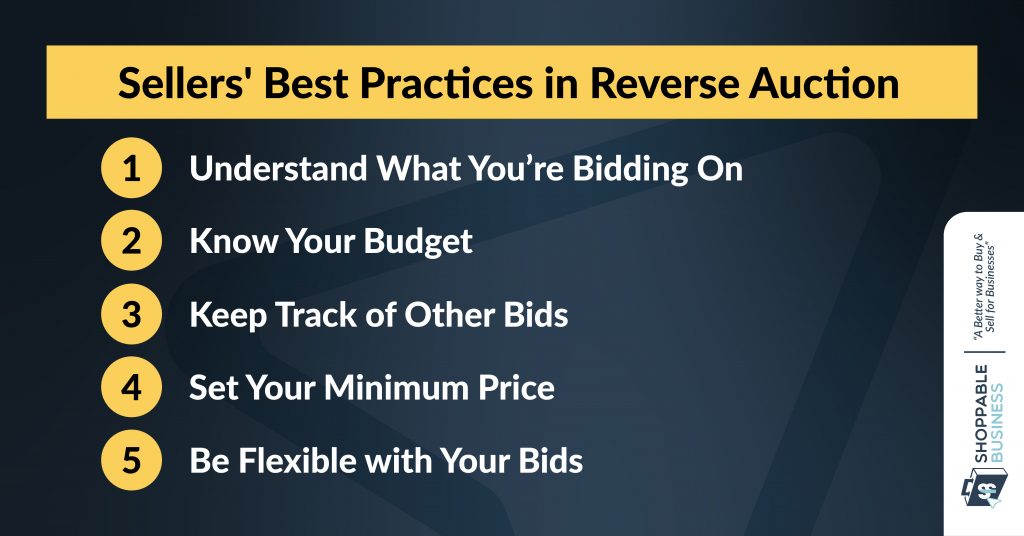
1. Understand What You’re Bidding On
Take the time to fully understand the Request for Proposal (RFP). Knowing exactly what the buyer wants helps you tailor your bid to meet their needs better.
2. Know Your Budget
Before placing your bid, make sure you know your costs for making and delivering the product or service. This keeps you from making offers that won’t be profitable.
3. Keep Track of Other Bids
During the auction, stay aware of what other bidders are offering. This helps you stay competitive while protecting your profit margins.
4. Set Your Minimum Price
Decide the lowest amount you’re willing to accept before the auction starts. This ensures you don’t end up with a deal that isn’t financially worthwhile.
5. Be Flexible with Your Bids
Since auctions can move quickly, be ready to adjust your bid on the spot. Being adaptable can give you an edge and help you secure the contract.
Main Points to Remember
Reverse auctions can be a game-changer in B2B procurement, especially when you need competitive prices and want to involve many suppliers. They simplify the process, saving both time and money.
But don’t focus solely on cost. Be sure to include clear quality standards in your contracts. Sometimes, spending a bit more for better quality or faster delivery can be a smart investment, leading to better long-term results.
Make your procurement workflow easier with Shoppable’s latest tool, Quotable. It’s a FREE and easy-to-use software designed especially for MSMEs in the Philippines.
Check out how Quotable can make your business operations easier by visiting:









